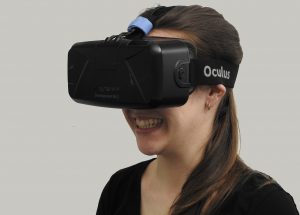
Social Anxiety Disorder (SAD) is characterised by a marked and persistent fear or anxiety in single or multiple social situations that have the potential for scrutiny (Aderka et al., 2012; Hofmann et al, 2012).
Scrutiny refers to a critical examination or observation; scrutiny can occur in social situations (e.g., meeting unfamiliar people) or in which people are observed eating, drinking or performing (e.g., giving a speech in front of an audience; Rodebaugh et al, 2004). During such events, individuals with social anxiety disorder may fear they will be judged as anxious, weak, crazy, stupid, boring or unlikeable. They are also likely to experience the physical affects of anxiety, such as a quickened heart rate, nausea, sweating and trembling (Scott, Canton, & Glue, 2012).
Such difficulties often lead people to avoid fearful situations. When they are in such situations, however, they experience significant anxiety and distress (Scott et al, 2012).
Social anxiety disorder is one of the most common mental disorders, with a lifetime prevalence of 12.1% in the US (Kessler et al., 2005). Although existing psychological and pharmaceutical treatments are effective in reducing Social Anxiety Disorder symptoms, research suggests that only 35.2% of individuals with the condition seek treatment (Kerns et al, 2013).
Technology-assisted, psychological treatment offers a cost-effective and convenient alternative to face-to-face approaches, one that may overcome some of the barriers that preclude individuals with Social Anxiety Disorder from seeking therapy (Hedman et al., 2014). This blog reviews a recent meta-analysis by Kampmann, Emmelkamp and Morina (2016), which investigated the efficacy of technology-assisted interventions for individuals with Social Anxiety Disorder.

Social anxiety disorder is associated with elevated rates of school dropout, decreased well-being, employment, workplace productivity and quality of life.
Methods
A systematic review incorporating all randomised controlled trials (RCTs) of technology-assisted interventions for adults with Social Anxiety Disorder was conducted from 1985 to April 2013 and from 2013 until June 2015. The electronic databases PsychInfo, Medline and Web of Science were used for a search of SAD-related keywords (e.g., social anxiety and social phobia) and technology-assisted interventions (e.g., computer-assisted, Internet, virtual reality).
They included RCTs where treatment targeted SAD symptoms, in adults who met the criteria for a diagnosis of SAD. Trials had to have at least 10 participants receiving the treatment condition. Symptoms were assessed at the post-assessment or earlier. No language restrictions were applied.
Based on the results of the systematic review, the authors categorised technology-assisted psychological interventions for Social Anxiety Disorder in three ways:
1. Internet-delivered cognitive behaviour therapy (ICBT)
Cognitive behaviour therapy aims to decrease maladaptive behaviours (e.g., avoidance behaviours) and increase adaptive ones by addressing unhelpful ways of thinking, feeling and behaving. Internet-delivered CBT (ICBT) is provided with either the guidance of a therapist or a self-help program.
2. Virtual reality exposure therapy (VRET)
Virtual reality exposure therapy (VRET) is a new technology-based form of exposure therapy through which, via computer-generated virtual situations, individuals with SAD are systematically exposed to feared social situations in a highly controllable environment.
3. Cognitive bias modification (CBM)
Cognitive bias modification is an innovative approach to modifying cognitive biases that confer vulnerability to anxiety. Social anxiety disorder, for example, is associated with environmental threat attentional and negative interpretation biases. Online CBM interventions aim to modify the attention and interpretation biases via the repeated practice of cognitive tasks.
The validity of the included studies chosen for the meta-analysis were assessed by two raters, according to the criteria of the Cochrane Risk of Bias Assessment Tool.
Data analysis
Initially, 5,145 abstracts were selected; 3,830 of them remained after duplicate removal. Of these, 3,624 records were excluded, because they did not meet the inclusion criteria, resulting in 206 full-text articles. A further 169 full texts were excluded, because they met the exclusion criteria, resulting in 37 RCT included in the meta-analysis (N = 2991).
The aggregated effect sizes were calculated using the Comprehensive Meta-Analysis (CMA: version 3.0), and they were conducted separately for each of the ICBT, VRET and CBM groups. A random effects model was used to account for heterogeneity:
- First, the aggregated uncontrolled effect sizes (the change from pre- to post-treatment, pre-assessment to follow-up 1 and pre-assessment to follow-up 2) were calculated to ascertain the effects of each treatment condition on SAD and depression symptoms and on quality of life.
- Secondly, the aggregated controlled effect sizes (the difference between treatment condition M and control condition M) were calculated for studies that contained at least one passive or active control condition (not similar to the active treatment condition). The significant findings on the primary SAD outcomes are reported below.
Results
- Findings demonstrated that ICBT is an effective treatment for SAD
- Preliminary evidence suggests VRET might have comparable effects
- However, CBM only exhibits small effects on SAD symptoms when delivered in a controlled laboratory environment.
1. Effect of ICBT on social anxiety disorder symptoms
- Uncontrolled effect sizes: A large effect was found at the post-assessment (g = 0.96, 95% CI [0.86 to 1.06], SE = 0.05, p < 0.001, k = 34), follow-up 1 (g = 07, 95% CI [0.86 to 1.28], SE = 0.01, p < 0.001, k = 13) and follow-up 2 (g = 1.17, 95% CI [1.01 to 1.32], SE = 0.08, p < 0.001, k = 11)
- Controlled effect sizes: A large effect was found, relative to the passive control conditions, at the post-assessment (g = 0.84, 95% CI [0.72 to 0.97], SE = 0.07, p < 0.001, k = 16)
- Small-to-medium effect size in comparison to the active control conditions at the post-assessment (g = 0.38, 95% CI [0.13 to 0.62], SE = 13, p < 0.01, k = 8) and follow-up 2 (g = 0.23, 95% CI [0.04 to 0.43], SE = 0.10, p = 0.02, k = 5)
- Heterogeneity was moderate for the controlled effect size in comparison with the active control conditions [Q(7) = 16.74, p = 0.019, I2 = 58.18], and low for the controlled effect size in relation to the passive control conditions at the post-assessment [Q(15) = 33, p = 0.798, I2 = 0.00]
- Guided ICBT: A large effect was observed at the post-assessment when compared to the passive control conditions (g = 87, 95% CI [0.72 to 1.02], SE = 0.08, p < 0.001, k = 11)
- Unguided ICBT: A medium controlled effect size was observed when compared to the passive control conditions at the post-assessment (g = 0.78, 95% CI [0.50 to 1.05], SE = 0.14, p < 0.001, k = 5).
2. Effect of VRET on social anxiety disorder symptoms
- Uncontrolled effect size: Large effect size was found at post-assessment (g = 1.09, 95% CI [0.80 to 1.39], SE = 0.15, p < 0.001, k = 3)
- Controlled effect size: Large effect size compared to passive control conditions was found at post-assessment (g = 82, 95% CI [0.13 to 1.51], SE = 0.35, p = 0.019, k = 3)
- Heterogeneity was low for the controlled effect size of VRET relative to active control conditions at post-assessment [Q(2) = 05, p > 0.05, I2 = 50.66].
3. Effect of CBM on social anxiety disorder symptoms
- Uncontrolled effect sizes: Large effect size found at post-assessment (g = 0.79, 95% CI [0.55 to 1.03], SE = 0.12, p < 0.001, k = 14) and follow-up 1 (g = 0.83, 95% CI [0.51 to 1.16], SE = 0.17, p < 0.001, k = 9), and a medium effect at follow-up 2 (g = 0.68, 95% CI [0.46 to 0.90], SE = 11, p < 0.001, k = 3)
- Controlled effect sizes: Not significant when compared to passive control conditions at post-assessment or follow-up time points
- Heterogeneity was low for the controlled effect size comparison of CBM and passive control conditions at post-assessment [Q(13) = 18, p =. 361, I2 = 8.34].

This review suggests that computerised cognitive behavioural therapy (ICBT) is an effective treatment for SAD, with larger effect sizes found for guided interventions.
Conclusions
These synthesised findings demonstrated the fact that, while the efficacy of CBM was limited, substantial evidence for ICBT and preliminary evidence for VRET indicates that both can effectively reduce SAD symptoms, suggesting the potential of technology-assisted interventions for reducing both severity and occurrence of SAD symptoms.
The authors conclude:
Future research is needed to investigate how to increase treatment efficacy and access of technology-assisted interventions that have the potential to help overcome shortcomings of traditional treatments with regard to the acceptance and implementation of psychological interventions for individuals with SAD.
Strengths and limitations
The meta-analysis was carried out according to a high standard and best practice. Research to date shows that both cognitive therapy and exposure, alone or in combination, demonstrate considerable efficacy for social anxiety disorder. However, little is known about the relative efficacy of the various components of CBT in social anxiety disorder (Kocovski et al, 2015), particularly when delivered online. Nevertheless, due to the varying number and quality of included trials across each of the three treatment domains (ICBT, VRET and CBM), the current meta-analysis is unable to demonstrate a comparative efficacy; thus, the authors’ conclusion that the synthesised findings provide divergent results for different treatment modalities of SAD should be interpreted with caution.
Another limitation of this meta-analysis is the varying focus of its included interventions. For example, the authors themselves state that some of the VRET interventions focused on performance anxiety only, whereas others focused on generalised social anxiety. Likewise, some of the CBM interventions predominately focused on external attention biases and not on more cognitively orientated biases, such as negative interpretation biases. Furthermore, the behavioural component of CBT often includes systematic exposure work. It is uncertain whether this was administered via ICBT; if it was, further questions relate to the method of administration and differences from VRET. Heterogeneous and/or overlapping treatment focuses within each of the treatment conditions may limit the generalisation and strength of the meta-analytic findings regarding each of the treatment modality outcomes.
Nonetheless, the authors acknowledged the potential methodological issues of their study, including the varying characteristics (e.g., differing follow-up durations), quantity and quality of the included technology-assisted interventions. Moreover, to account for heterogeneity across studies, they used a random effects model when calculating the mean effect sizes.
Another strength worth noting is that the authors provided a comprehensive report on both primary outcomes (e.g., SAD symptoms) and secondary outcomes (e.g., depressive symptoms, quality of life); in addition, they demonstrated the efficacy of guided ICBT for clinical populations and CBM when delivered in a controlled laboratory environment.
Summary
The findings of Kampmann et al.’s (2016) meta-analysis indicate that, although the efficacy of CBM was limited, the evidence for ICBT and the preliminary evidence for VRET suggest that both can effectively reduce social anxiety disorder symptoms, in turn, indicating the potential of technology-assisted interventions for SAD.
Given the considerable distress associated with SAD and particularly, the associated impaired ability to function in at least one domain of daily life (Werner et al., 2012), more research is warranted in order to extend the investigation of the effects of online treatment for SAD on general functioning (e.g., quality of life, overall social functioning and the subjective quality of social relationships).
Additionally, as subjective well-being also encompasses individuals’ subjective positive affect (Lyubomirsky et al, 2005), outcomes should examine the effect of particular SAD interventions on participants’ positive affect.

These promising results suggest that further research into digital interventions for social anxiety disorder are warranted.
Links
Primary paper
Kampmann IL, Emmelkamp PM, Morina N. (2016) Meta-analysis of technology-assisted interventions for social anxiety disorder. J Anxiety Disord. 2016 Aug; 42: 71-84. doi: 10.1016/j.janxdis.2016.06.007
Other references
Aderka, I., Hofmann, S. G., Nickerson, A., Hermesh, H., Gilboa-Schechtman, E., & Marom, S. (2012). Functional impairment in social anxiety disorder. J. Anxiety Disord., 26(3), 393-400. doi: 10.1016/j.janxdis.2012.01.003
Hedman, E., Elalaoui, S., Lindefors, N., Andersson, E., Rück, C., Ghaderi, A., . . . Ljótsson, B. (2014). Clinical effectiveness and cost-effectiveness of Internet- vs. group-based cognitive behavior therapy for social anxiety disorder: 4-Year follow-up of a randomized trial. Behaviour Research and Therapy, 59(20), 20-29. doi: 10.1016/j.brat.2014.05.010.
Hofmann, S. G., Asnaani, A., Vonk, I., Sawyer, A., & Fang, A. (2012). The Efficacy of Cognitive Behavioral Therapy: A Review of Meta-analyses Cogn. Ther. Res. 36(5), 427-440. doi: 10.1007/s10608-012-9476-1
Kerns, C. E., Comer, J. S., Pincus, D. B., & Hofmann, S. G. (2013). Evaluation of the proposed social anxiety disorder specifier change for DSM-5 in a treatment seeking sample of anxious youth. Depression and Anxiety, 30(8), 709–715. doi: 10.1002/da.22067
Kessler, R. C., Birnbaum, H., Bromet, E., Hwang, I., Sampson, N., & Shahly, V. (2010). Age differences in major depression: results from the National Comorbidity Survey Replication (NCS-R). Psychol. Med., 40(2), 225-237. doi: 10.1017/S0033291709990213
Kocovski, N., Fleming, J., Hawley, L., Ho, M.H., & Antony, M. (2015). Mindfulness and acceptance-based group therapy and traditional cognitive behavioral group therapy for social anxiety disorder: Mechanisms of change. Behaviour Research and Therapy, 70(11). doi:10.1016/j.brat.2015.04.005
Lyubomirsky, S., Sheldon, K., & Schkade, D. (2005). Pursuing happiness: The architecture of sustainable change. Rev. Gen. Psychol., 9(2), 111-131. doi: 10.1037/1089-2680.9.2.111
Rodebaugh, T. L., Holaway, R. M., & Heimberg, R. G. (2004). The treatment of social anxiety disorder. Clinical Psychology Review, 24(7), 883-908. doi: 10.1016/j.cpr.2004.07.007
Scott, K., Canton, J., & Glue, P. (2012). Optimal treatment of social phobia: systematic review and meta-analysis. Neuropsychiatric Disease and Treatment, 2012(default), 203-215. doi: 10.2147/NDT.S23317
Werner, K., Jazaieri, H., Goldin, P., Ziv, M., Heimberg, R. G., & Gross, J. (2012). Self-compassion and social anxiety disorder. Anxiety Stress Coping, 25(5), 543-558. doi: 10.1080/10615806.2011.608842

Digital interventions for social anxiety disorder: new meta-analysis finds mixed results https://t.co/g2gbkowRDG #socialanxiety #cbt #online
Digital interventions for social anxiety disorder: new meta-analysis finds mixed results https://t.co/PZxVRlQWbs
Today @Carla_McEnery on recent meta-analysis of technology-assisted interventions for Social Anxiety Disorder https://t.co/eAfPYUeL5k
MA finds positive results for Internet-delivered CBT & Virtual Reality Exposure Therapy for Social Anxiety Disorder https://t.co/eAfPYUeL5k
@Mental_Elf Eh?
#Digital interventions for #socialanxiety disorder https://t.co/sIJYtx4Hf6 new #metaanalysis finds mixed results says @Mental_Elf
Review says computerised CBT is effective for social anxiety disorder, with effect sizes for guided interventions https://t.co/eAfPYUeL5k
effect sizes for guided interventions https://t.co/eAfPYUeL5k
https://t.co/Seyf9fisfi
RT @Mental_Elf: Social anxiety associated with
 school dropout
school dropout
 well-being
well-being
 employment
employment
 work productivity
work productivity
 quality of life
quality of life
https:…
Digital interventions for social anxiety disorder
New meta-analysis finds mixed results
https://t.co/eAfPYUeL5k https://t.co/1W1xGrWhQo
Evening all #mhchat
Please read our brand new blog on digital interventions for social anxiety disorder
https://t.co/eAfPYUeL5k
Digital interventions for social anxiety disorder: new meta-analysis finds mixed results https://t.co/EQ9XS3Lqp1 via @sharethis